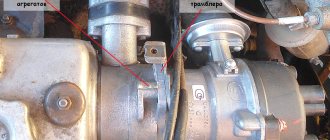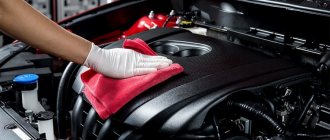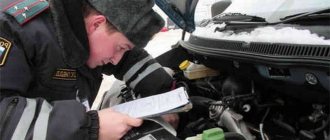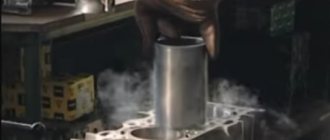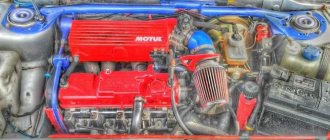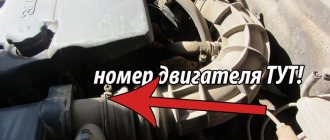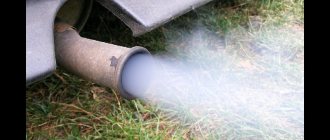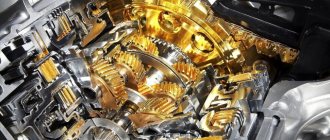Small tricks
In various instructions on the Internet, the process of replacing pillows is described very simply and unpretentiously.
There is a feeling that this work will take no more than an hour, and even a person without experience can cope with it. But in practice you usually have to tinker. Difficulties arise due to poor access to nuts and tight space for maneuvering with spare parts. As a result, work can drag on for the whole day and be quite nerve-wracking.
To avoid this, we recommend that you carefully watch the video at the end of this article.
Here we list a few tips that will make your work easier.
- The jack is placed under the clutch bell. A spacer in the form of a 20x20cm board is used.
- There is no need to lift the engine too much. The exhaust pipe will rest against the steering rod, which will lead to the body lifting along with the engine. Of course, you can remove the steering rod or exhaust pipe, which will allow the engine to rise a little higher until the clutch bell stops in the floor tunnel.
- The left cushion is very easy to remove. Therefore, most lessons are based on the example of this particular support. You will have to tinker a little longer with the right support.
- To remove the left support, just use a pry bar or simply push the engine away from you. The pillow is pressed against the beam and pulled towards itself.
- Before installing a new cushion, check the tightness of all nuts on it and tighten them if necessary.
- Clean the installation site from dirt and rust accumulated over the years.
- When installing, first place the bottom pin in the slot on the beam. Then we press on the engine and insert the upper pin into the cushion bracket. Since the engine is raised slightly, the part fits perfectly into place. So there is no need to cut off the pin to fit it in there.
- Things are a little more complicated with the right pillow. The fact is that access to the upper fastening nut is difficult. But this can be solved. A long 17mm socket and a ratchet will help. With this simple device you can unscrew the nut from under the car. But it will be quite difficult to do this from above. This is due to the fact that the pillow is located at an angle to the block.
- In order for the new cushion to fit into the bracket, you must first get the lower pin into the hole on the beam, then lift the engine in the area of the generator and put the upper pin in place.
- Don't forget to put a heat shield on the right pillow. Otherwise, it will not live long due to overheating from the exhaust.
- When installing the rear cushion in the traverse, do not confuse where the back is and where the front of the cushion is. Otherwise, you will have to take it out and screw it on again.
- To fasten the traverse to the body, you need to lift the box using a jack. This will allow you to press the traverse to the bottom and successfully tighten the nuts. This will avoid the need to lift the box on its hump and tighten the nuts, bent halfway.
To replace the pillows we will need
You don't need many tools to change the engine mount yourself. Of the important tools we will need to take the following:
- key to 17;
- key to 13;
- jack;
- board with dimensions 40x20. Be sure to take into account that it must be longer than the inspection hole or overpass;
- board 30 millimeters thick and with dimensions 20x20.
Be sure to buy pillows in advance. After all materials and tools have been prepared, you can proceed to the replacement procedure.
The procedure for changing engine mounts is as follows:
- Drive your car onto the overpass.
- Place supports under the wheels to prevent it from sliding backwards.
- Remove the mudguard. Removing it will provide access to the first engine mount.
- Unscrew the front support nut. This is done using the key 17.
- Now find the lower nut of the VAZ 2107 engine mount and unscrew it with the same key.
- Take a jack and lift the engine. This is necessary in order to easily pull out the pillow. The support is under the weight of the power unit and you simply cannot remove it without lifting the engine.
- The jack is installed on a board, which must first be placed on the inspection hole. Experienced mechanics warn that the board must be strong and thick. Its edges should extend beyond the inspection hole by twenty centimeters. This way it will be able to support the weight of the motor and not break under it.
- Another board is laid on the jack. This is done so that the jack, when it puts pressure on the power unit, does not push through the housing and damage the engine.
- The engine starts to rise.
- The power unit will rise by twenty centimeters. This should be enough to remove the support.
- The second pillow is removed in the same way.
Similar article Engine from a foreign car for a VAZ 2107 without modifications
Another thing is with the rear engine mount. To remove it, they do things a little differently. The cushion itself is fixed under the gearbox yoke. To remove the support, you will need to unscrew the traverse.
How to do it:
- First of all, unscrew the nuts that hold the traverse. Usually there are two.
- After they are unscrewed, remove the fastenings of the rear engine support from the gearbox.
- Afterwards, the traverse is removed along with the pillow.
- Take a wrench for thirteen and use it to unscrew the traverse from the removed support.
- A spacer is installed between the engine mount mounts. You need to remember about it when you reinstall the engine support.
After reading this manual, you will think that replacing the engine mounts is easy. However, do not forget that experienced mechanics keep some tricks to themselves, without which a beginner will have to work hard to remove the engine mounts.
Let's look at these tricks:
- the jack is installed under the clutch bell, and not under the engine itself;
- the power unit is raised only 20 centimeters to pull out the pillow. If you raise it higher, the body and the engine can also rise;
- to remove the left cushion you can use a simple pry bar;
- To dismantle the right one you will need to take a ratchet. Using it and a 17mm socket, unscrew the nut, which is located inside a small recess;
- The place where the support will be installed must be cleared of dirt and debris that has accumulated there.
You will also have to work hard during installation. Many people cut off the pin that is inserted into the beam. This can be avoided if you first insert it into the slot on the beam, and then press on the power unit and insert the upper pin into the bracket.
Attention! When you screw the yoke to the car body, do not forget to raise the gearbox using a jack. This way you will press it to the bottom and successfully tighten all the nuts.
How to replace an engine mount
What is an engine stroker?
It is necessary to replace engine mounts in a heated box or garage (at least in the warm season), since working with rubber elements in the cold will be complicated by an increase in the rigidity of the material as a result of exposure to cold air. To make work easier, the car should be placed on an inspection hole or overpass. To avoid a short circuit, remove the terminals from the battery.
The location of the supports and their mounting options depend on the vehicle. In some cases, the operation is not difficult; in others, on the contrary, getting to the elements is quite problematic. Let us describe the process of replacing engine mounts using the example of a VAZ-2110.
Replacing the right engine mount.
To perform the replacement, you need a set of tools and accessories, including a jack, a set of keys, and repair supports. The vehicle will need to be raised using a jack and supports installed. Then you should slightly raise the power unit using a wooden plank placed between the jack and the crankcase protection. The board will help distribute forces and minimize the risk of deformation of the pallet
During the process of lifting the internal combustion engine, it is important to monitor the radiator and fan shroud.
Through bolts are used to secure the supports to the frame. After removing the bolts, dismantling the old pillow will not present any difficulties.
After replacing the engine mount, it is necessary to assemble the parts in reverse order.
It wouldn’t hurt to treat the bolt threads with lubricant, then it will be easier to unscrew it next time.
Replacing the left engine mount.
After replacing the right engine mount, you need to check the condition of the left mount. It minimizes vibrations from the transmission. The jack must be moved from under the power unit to the box, put a board under it and lift it a little. This removes the load from the cushion, making it easier to dismantle. To do this you will need a 15mm socket wrench and an extension. First of all, unscrew the support stud nut and remove the upper stop.
To remove the stud, you need to lower the transmission slightly. To secure the support to the body, two 13mm bolts are used. After unscrewing them, the cushion can be moved towards the internal combustion engine. After this, you need to remove the upper limiter. Installation is carried out in reverse order. The main thing is that the pin fits exactly into the oval hole of the gearbox bracket, otherwise it will begin to rotate, which will not allow it to be tightened.
Replacing the rear engine mount.
The rear engine support is collapsible, which allows you to purchase the element itself without a bracket. However, assessing the condition of the old mount is extremely important; the presence of cracks and other signs of wear will indicate the need to replace the engine mount assembly.
Replacement of the rear support is carried out according to the previously described algorithm. The nuts securing the supports to the body and transmission are removed. The cushion is dismantled and the condition of the bracket is assessed. If there are no signs of wear, then you can purchase a support without fastening.
To replace the engine mount, you need to secure the bracket with a vice, unscrew the central nut, remove the support, then install a new one and tighten the nut. Install the cushions in the engine compartment in the reverse order.
Replacing the front engine mount.
The front support wears the most. Its failure threatens with strong vibrations coming to the body. When the first signs of a malfunction appear, it is worth replacing the engine airbag. The operation is quite simple, involving unscrewing the nuts securing it to the body, removing the support and installing a new one, assembling the parts in the reverse order.
Foreign cars usually have a similar number of supports, differing in size and shape. This difference is especially noticeable in the front airbag. The more densely the components and assemblies of the internal combustion engine are arranged, the more parts will have to be dismantled to replace the airbag.
After replacement, the engine must be started. Correctly carried out repair work will be characterized by minimal vibration or its complete absence. The appearance of strong vibration after replacing the engine mount will require re-checking the correct installation of parts and the quality of their fastening.
However, vibration after replacing engine mounts may be caused by other reasons.
Replacing the engine mount if a malfunction is detected
If you need to replace the engine mounts, the signs of malfunction described above will usually allow you to get to the nearest car service center or your own garage on your own. But you should drive carefully, if possible at a speed no higher than 60 km/h. The rear or left cushion is usually subject to wear. A detected malfunction of one support will most likely entail the replacement of the second pillow. At the end of the inspection, you need to purchase the necessary spare parts in advance - you won’t be able to go get them by car while replacing the airbags.
Preparing to replace the engine mount
It is recommended to carry out work on replacing supports in a warm place, since the rubber used at low temperatures hardens and loses elasticity. This will significantly complicate the process.
It is also advisable to drive the car into an inspection hole and carry out the replacement from there, having first disconnected the battery terminals. They often begin to inspect the left front side of the engine, where the airbag malfunction appears in most cases and access to which is most convenient.
A torn mount can be repaired, since the price of a new mount for a foreign car engine is about 2,000 rubles (and for an SUV it is twice as high). If the rubber element is damaged, the support will have to be changed in any case.
Engine mount replacement process
First of all, protective elements are removed from the motor to facilitate access to the necessary parts. A jack is then placed under the engine to provide support while the mounts are removed. If the process takes place in a viewing hole, you can lay a wide, fairly strong board across it and install a jack on it.
Next, the unit is raised with a jack until it is possible to freely unscrew the support being replaced. After unscrewing the mounting screws and removing the old support, a new one is installed in its place, and the operation is repeated in the reverse order.
Replacing a rear airbag is usually associated with certain difficulties. This support experiences the greatest loads during engine operation. As a result, all fasteners are deformed, including bolts. The shape of the fastener differs from other supports.
Here a jack will no longer be enough. To free the support, it is best to hang the motor from the upper beam. If this is not possible, you can build a crossbar on two glasses, lifting the engine with a jack in advance. In some car models, external components may interfere with troubleshooting and will have to be removed. It is more efficient to cut off a severely deformed pillow fastening bolt with a cutting wheel. Sometimes they try to align and unscrew such a bolt, but after a while it will still have to be replaced.
The old support often sticks to the frame and forms rust due to the accumulation of dirt. Oil or a product like WD-40 can help remove it.
It is important to install the new rear support correctly. The arrow on the support should point forward, in the direction of travel of the machine. The rest of the assembly is carried out in reverse order.
After replacing the rear support, you can proceed to the right
Here, too, there is a possibility of encountering deformed bolts, but a more serious problem lies in the generator or car air conditioning compressor located here. It is known that removing the compressor can lead to depressurization of the circuit and leakage of refrigerant.
If the repair takes place at a service station, it is better to subsequently check the air conditioner for possible malfunctions. Short-sighted car service employees sometimes remove the compressor themselves to save time, without warning the car owner about it.
In foreign cars, in most cases, the right engine mount is located closer to the front. Therefore, to access this cushion, the right headlight and radiator grille are often removed.
Some of the deformed bolts cannot be cut off even with a grinder, since access to them is limited by other neighboring elements or simply cannot be reached. In this case, it is better to use a regular hacksaw, cutting off the damaged bolt by hand.
This procedure will take much longer, but at least this way you will not damage adjacent parts and components. The new support is placed in place of the old one as usual, in reverse order. When installing the radiator grille, you need to be careful - the radiator honeycombs are sharp enough to cut yourself.
Safety at work
The most important thing is to fix the motor securely and safely. A second assistant is desirable for assistance and backup.
Torn engine mount: signs
What is an engine crankshaft in a car?
Like any other part, the power plant support also has a limited service life and eventually fails. On average, airbags on modern cars are designed to last at least 100-120 thousand km, although in practice these elements may need to be replaced both earlier and much later than this period.
Usually the cause of problems is the rubber insert, which simply cracks and breaks under load. Less often, cracks appear in the metal part of the support, the installation sites of fasteners are broken, etc.
One way or another, the following symptoms usually indicate a malfunction of the engine mounts:
- The engine itself runs smoothly, but the driver feels a clear increase in vibrations in the body, on the steering wheel, on the gearshift knob, etc.;
- When you start moving from a standstill, as well as during braking, you can hear clicking or muffled knocking in the engine compartment;
- When driving on an uneven road, impacts are heard from the front of the car; in many cases such impacts are felt on the gearshift lever; shifting gears with a manual transmission at this moment can be difficult;
To check the engine mounts, it is not necessary to immediately go to a service station and drive the car to a stand. Usually, a fault can be identified and localized on your own, even if you do not have much experience in car repair and maintenance.
The simplest method of initial diagnosis is to rock the engine with your hands in the engine compartment, after which you can localize a torn or cracked support by knocking.
Another technique for diagnosing engine mounts is when the hood is first opened and fixed, then the car is started and jerked forward in first gear. The car moves backwards in the same way. At this time, an assistant outside monitors the vibrations of the internal combustion engine.
To carry out a more detailed check, you first need to find out in advance where exactly the supports are located on a particular model. Then the elements available for review will need to be pre-inspected. Cracks, breaks and other damage are usually visible and easily visible.
For a full visual assessment of the lower airbags, you need to be prepared for the fact that the car will need to be parked in a garage with an inspection hole, driven onto an overpass, or using a lift.
If a superficial diagnosis shows nothing, then the assistant should be used again. One person uses a pry bar to move the support, while the other watches for tears in the rubber insert at the very moment the support moves. It happens that some cracks are not immediately visible without rocking.
After detecting a torn engine mount, the damaged element should be replaced. It is not recommended to try to press the rubber insert out of the cylinder in order to save on spare parts, since such makeshift repairs often do not bring the desired results.
As for the replacement itself, replacing the top cushion is quite simple. The car needs to be jacked up, the old cushion removed and a new one installed.
If you have to change the lower supports, it is also important to consider that the engine goes down after removing this cushion. This means that an additional support will be required that supports the internal combustion engine, allowing you to direct the pillow and correctly secure this element
Diagnostics of engine mounts
Signs of wear on engine mounts
Worn engine mount
Depending on which engine mount is torn, signs of its malfunction may include:
- Engine vibration at idle.
- Extraneous knocks while driving, felt in the engine compartment or under the gearbox.
- Jerks during dynamic acceleration of the car.
- Knocks in the engine compartment when starting or stopping the engine.
- Difficulty shifting gears.
On cars with hydraulic supports, the acceleration dynamics may also deteriorate. Visually faulty airbags can be identified by delamination and rupture of rubber dampers or breakage of aluminum brackets. An experienced specialist can also visually identify a sagging pillow by how severely its damper is deformed.
Types of pillows
Types of car engine mounts
Despite the variety of design options, the general purpose of the cushions is to act as an engine mount, i.e. dampen vibrations and vibrations of the power unit. The role of an engine damper is usually played by rubber (sometimes in interaction with the hydraulic properties of the oil), absorbing shocks and vibration, while preventing displacement of the power unit. As an example, we can take the motor mount on the Niva. It is a rubber cylinder with plates with threaded rods welded to it. The left and right engine mounts are absolutely identical, the third, which supports the gearbox , has a slightly different appearance and is mounted on a crossbar attached to the bottom of the car. The dimensions of the supports and their attachment points are designed in such a way as to prevent displacement of the power unit, while the weight of the engine compresses the cushion and is distributed so that rupture of the rubber due to its shear deformation is practically eliminated. In a similar way, the engine, also located longitudinally to the axis of the car, was installed on the Volga. But with a transverse engine arrangement, it is somewhat more difficult to balance it, due to the design of the power unit as a whole. Therefore, the supports most often take the form of suspension arms, which have silent blocks as an engine damper, as on the additional supports of the VAZ 2112: This design of supports is also sometimes caused by the need to support the points of the engines most distant from the body, which after modernization have acquired a large mass. The use of additional supports allows the installation of heavier engines without significant changes to the vehicle design. The most typical method for relatively small power units is the method of “hanging” them, as on 2108 -09. The engine and gearbox assembly has three mounting points:
- left engine mount;
- rear (lower) engine mount.
Article on the topic: How to change rights when changing your last name
How do engine mounts work?
Car engine support mounts
The cushions work similarly to the silent blocks of the suspension arms, that is, they twist the rubber. Therefore, on cars driven primarily on bad roads, because... Such supports turn out to be unreliable - the rubber delaminates. More compact cars, which are relatively heavy (relative to the total weight of the car), are suspended somewhat differently - the rubber damper in them works in compression and tension, which increases its service life. In addition, such supports fix the engine more rigidly. But the weak point of such supports can be the engine mount mounting bracket that is too long, if it is a single unit with it and is made of aluminum alloy. If the tires “sag”, careless driving on an uneven road can lead to its breakdown. Hydraulic (or hydromechanical) engine mounts differ from conventional ones in that they have variable stiffness. This is achieved by taking vacuum from the engine. When a certain number of revolutions is reached, the valve separating the support chambers closes. As a result, the liquid (antifreeze), which previously flowed from chamber to chamber, begins to play the role of an elastic element. Externally, such supports differ mainly in the presence of a fitting for connecting a vacuum hose and cable. Such cushions are intended to dampen vibrations from the motor, the bulk of which “lies” on other supports.
What is an engine mount (mount) and what is it intended for?
Classification, design and operating principle of engine timing
Engine mounts are special units with which the engine is secured to the frame, subframe or. To perform its job reliably, the support must have high wear resistance and strength. Therefore, the design of the part is a steel base equipped with rubber pads in the areas of the junction with the motor. It is the latter that dampen the vibrations produced by a running engine.
Rubber-metal engine mounts
Main functions of engine mounts:
- To absorb shocks and jolts that occur when the vehicle is moving.
- Ensure effective vibration isolation of the passenger compartment at idle.
- Provide less wear on parts by reducing engine sway.
The design and principle of operation of various types of engine mounts
Regardless of the type of support and its design features, the operating principle is the same: shocks (oscillations) are dampened and the power unit is held in place.
However, parts of different categories have their own characteristics:
Rubber-metal mounts have a simple design: two metal plates connected to each other, between which a cushion made of the rubber stiffness required for a particular car and engine is placed. A more advanced design of these supports additionally contains buffers designed to soften impacts, and a spring that increases the rigidity of the part. Along with rubber elements, many manufacturers also offer a polyurethane analogue, which is more wear-resistant. Supports in this category can be permanent or collapsible. Rubber provides the vibrating engine with relative freedom of movement, and thus dampens vibrations quite well.
Dynamic engine mount
There are the following types of hydraulic support control:
- Mechanical - are developed separately for each make and model of vehicle, since the part will be based on either damping at a speed of strong vibrations or good noise insulation at idle;
- Electronic is a more advanced design. Allows you to control the rigidity of the part during movement via electronics. Thus, by increasing or decreasing the rigidity of the support, comfort at speed or at idle will be equally high.
- Dynamic (based on electromagnetic influence) - the operating principle of such units is to use magnetic fluid, i.e. containing magnetizable metal particles. As a result of such an effect, such a liquid changes the viscosity coefficient and, accordingly, the rigidity of the entire structure.
Today, hydraulic supports are the most popular, however, rubber-metal ones are still used. Regardless of what type of airbags are installed in the car, it is not recommended to quickly start moving from a standstill or drive through deep bumps on the roads at high speeds. This can quickly destroy them.
Types of supports
Modern engine mount
can be
rubber-metal
or
hydraulic
.
Rubber-metal supports have an extremely simple design: a pair of plates made of steel or other metal with a not too thick gasket between them made of good wear-resistant rubber. This is the cheapest and most popular engine mount right now. In some models, springs are additionally built into the cushions, increasing rigidity and buffers, allowing them to somewhat soften the strongest impacts. Increasingly, new cars are produced with polyurethane cushions, due to its greater wear resistance. It is the polyurethane engine support cushion that is used in sports cars, as it increases and optimizes rigidity. The rubber-metal engine mount can be dismountable or non-removable.
Engine hydraulic cushion device.
The hydraulic engine mount is considered a much more modern design. Such systems are able to adapt to engine operation in different conditions and dampen any vibrations as effectively as possible. The engine support cushion is also made of three main elements, but here it is a pair of chambers with a membrane between them. Each chamber is filled with antifreeze or hydraulic fluid. The task of the movable membrane is to eliminate minor vibration that occurs at idle and low speed on a flat road. High-speed vibrations are eliminated by hydraulic fluid. Under the influence of changing pressure, it moves between the chambers, increasing the rigidity of the support, which allows it to dampen even the strongest vibrations.
hydraulic mount
Unlike a rubber-metal support, it can have a different design. The following types of engine mounts are currently common:
- mechanically controlled supports that can very effectively dampen one type of vibration (idling, high-speed, strong shocks), so they are configured differently for each car model;
- electronically controlled supports, which are mainly mounted on expensive cars, but are capable of automatically changing the stiffness characteristics to effectively counteract all types of operating vibrations;
- dynamic supports based on the use of a magnetic metallized liquid that changes viscosity under the influence of a magnetic field, which in turn is controlled by automotive electronics, due to which adaptability of support settings is achieved.
However, only the first type of engine mount can be considered widespread, since the others are too complex and expensive for use on truly mass-produced cars.
How to determine a breakdown
Failure of a support can occur due to natural causes or due to external factors (minor accidents, running into a sewer manhole or hole). Regardless of the cause, the malfunction manifests itself in the form of characteristic symptoms. Knowing these signs, the driver will be able to promptly determine the need to replace the airbag.
Signs of wear on engine mounts
- The appearance of body vibration. When operating a car, vibration or rattling is transmitted to the steering wheel and panel.
- Extraneous sounds. Most often they appear when accelerating a vehicle and changing gears.
- Problems with replacing the timing belt. With worn mounts, the engine sags a little, so it becomes difficult to carry out some repair work.
- Rapid wear of grenades. The service life of parts is reduced due to a violation of the geometry of the motor. Every degree of angle change is important for grenades to function properly.
- Knock in the area of the crossbar. A knocking sound appears when the gearbox slider hits the thrust housing.
Signs of faulty engine mounts
How to determine if an engine mount is damaged
It is difficult to immediately understand whether the engine or the vibration is transmitted from another part, the road. When starting the engine , vibration will be transmitted and some car enthusiasts sin that the engine has not warmed up, and therefore do not pay attention. There is a situation when even when the engine is warm, vibration appears and disappears even while driving. Repairing a pumping station with your own hands - Man v. When the engine is completely out of order, you will hear a characteristic creaking sound of metal on metal.
You can drive to the nearest service station or home with such symptoms, but you should not drive the car, preferably no more than 60 km/h. Often, the rear or left support wears out. You can get a good look at this in the inspection hole, where you can see both the side and rear airbags If you find a breakdown in one pillow, then get ready that another one will definitely have to be replaced. DIY brake caliper repair - video. After the inspection, prepare spare parts for replacement, since you will not be able to drive the car during the replacement.
Replacing engine mounts yourself
In order to keep your car in perfect order, you need to regularly check its technical condition. Since the failure of one part can destroy the entire expensive unit, it is necessary to promptly replace the faulty mechanism.
We offer you detailed instructions on how to change unsuitable engine mounts with your own hands:
- Having de-energized the battery by removing the terminals, the car is raised to a sufficient height to provide comfortable access to the engine. After using the jack, the car is securely fixed with wooden blocks;
- using the same lifting device, raise the motor, releasing the required part from the load;
- the engine mounts are fastened with a certain number of bolts, which must be removed after unscrewing;
- After removing the unusable part, a new spare part is installed in a suitable place. Fasteners in the form of bolts securely fix the engine hydraulic mount. It should be noted that running the motor while tightening the fasteners will protect the car from subsequent excessive vibration;
- completion of the installation of the engine support cushion is accompanied by the return of all dismantled parts to their proper places.
Inspecting and replacing the top cushion is a fairly simple process. The accessibility of manipulations is ensured by the ability to do without a pit. In addition, it is not necessary to lift the car.
Preparing to replace the engine mount
It is better to carry out replacement in warm weather or in a warm room, since the work will have to be done with rubber parts, and as you know, in the cold the rubber becomes hard, and replacement will be difficult. To replace it, it is best to go to the inspection hole. Next, disconnect the battery to avoid a short circuit. They often start the inspection from the front left side, since it is the easiest to change, and it most often fails. If the fastening is broken, it can be repaired, since engine mounts cost about 2,000 rubles for a simple foreign car, and about 4,000 rubles for an SUV. If there is a breakdown in the rubber part of the support, then you definitely need to install new ones. At a service station, such a replacement costs about 300,500 rubles for the front and side airbags, and about 700 rubles for the rear airbag .
avtoexperts.ru
The car engine is quite heavy and subject to vibration, so it must be secured against any displacement during operation. If the fastening points are rigidly connected to the body elements, they will fail very quickly, since when driving over uneven road surfaces, the fastening points will absorb significant alternating loads.
Plus, the entire body will constantly vibrate, which, in addition to discomfort for those inside the car, will also negatively affect the durability of all elements of the car.
Purpose
Special supports, or cushions as they are also called, are used to dampen vibrations during engine operation and to securely fix it.
The name of the support as a pillow is not accidental, as it fully corresponds to its purpose. So, in Ozhegov’s explanatory dictionary, one of the meanings of the word “pillow” is something that supports something, takes on the pressure of a mechanism.
The main task of installing supports is to securely fasten and minimize sideways movement during operation.
In addition, thanks to the pillows, the power unit is isolated from all body parts, which makes the car comfortable to drive.
Depending on the car model, the engine can have from 3 to 5 airbags.
So the front and rear airbags monitor vibration at idle and when the engine reaches maximum load.
Design
The simplest support is a rubber-metal element, where a layer of rubber is placed between two steel plates. The plates have a threaded part in the form of a pin at the ends for connection with body parts. Such products can be made either integral or collapsible.
Some supports, for example, the classic VAZ 2101-07 models, also had a spring and a rubber bumper inside the cushion, which increased rigidity and softened strong impacts.
Recently, increasingly, instead of rubber, manufacturers have begun to use polyurethane, as the most wear-resistant, and metal in most cases has given way to aluminum.
On more expensive car models, more modern designs, such as hydraulic supports, are used for greater driving comfort. They consist of two chambers and a membrane between them; the chambers are filled with liquid, which, when loaded, can move from one container to another.
Such supports can be adjusted to the operation of the power unit in any mode of operation and are capable of maximally damping any vibrations that occur, significantly increasing the degree of comfort when operating the car.
The greatest loads on the engine mountings occur when starting the engine, starting and stopping the vehicle. A faulty mount increases the stress on the engine and transmission, making them more likely to fail.
• Cracks, breaks in the filler body or steel plates;
• Peeling of rubber from metal;
• The motor “bounces” when starting and braking the car;
• Vibration radiating to the steering wheel, gear knob and the entire body;
• Shocks when changing gears;
• Impact when planing at reverse speed;
• When driving on an uneven road, knocking noises are heard, similar to a malfunction of the chassis.
Causes of malfunction
There can be several reasons for premature pillow failure. For example, when tuning a car, shock absorbers with a stiffer characteristic and low-profile tires are installed to improve handling and change the appearance of the car. However, in this situation, the shock absorbers in the pits do not completely dampen body vibrations, which have a negative effect on all suspension elements, including the engine mounts.
Driving style. These are sudden starts and braking that provoke huge loads on the engine mounts due to a rapid shift in the center of gravity. This also includes driving over bumps on the road without slowing down.
Natural wear and tear. These are mechanical loads, temperature changes, aging of the rubber filler, which loses its elasticity.
Replacement timing
On average, the power plant supports are capable of operating for about 100 thousand kilometers or more (up to 200 thousand) with moderate driving and proper monitoring of their condition.
If any signs of malfunction of the engine and gearbox mounts are detected, it is recommended to replace them without delay. At the same time, you should not purchase products from an unknown manufacturer, giving preference to the original.
Finally. Serviceable supports mean comfort and safety of movement, as well as extending the life of your power unit.
How does the engine mount work?
On many cars of different brands, engine mounts were made of dense rubber, which was screwed to the engine and to the body. Later, they began to make motor mounts with a more complex design, using rubber and metal. And some more expensive cars use hydraulic engine mounts; they provide more comfort when compared to conventional rubber mounts.
If on old cars like Moskvich there were only 2 motor supports, then on modern cars the motor is mounted on 4-5 supports. Typically, 2 supports are attached to the gearbox, and the rest to the motor itself. As for the connection between the motor and the gearbox, there is a rigid connection.
The motor is mounted using front, right and rear mountings. The right engine mount is mounted on the front side member. The front motor mount is attached to the front beam and is located at the bottom. Also at the bottom there is a rear cushion, which is attached to the subframe or bottom. Many cars have their own design features, so they may not have a rear support.
As for the design, the rubber-metal motor mounts differ in shape, depending on the model. But in most cases, the engine mount is a silent block into which a metal cylinder is pressed.
And then there’s a visual video about how you can install engine mounts from Niva on a VAZ 2106:
Number and location of engine mounts
The location of the supports is not known to many car owners until strong vibration begins when the engine is running.
Then the details will attract attention themselves, although they are not always visible under the hood. Most often, without special training and knowledge, you can only see the upper support
The main factors that determine the number of engine mounts and their location are the weight and position of the power unit in the engine compartment, as well as the type of vehicle body.
As a rule, 3 or 4 ICE supports are used to secure the power plant. Moreover, three-point fixation is the most common among almost all manufacturers. Despite the different method of location and method of their fastening, the fixation must be so reliable that there is no significant displacement of the motor during vehicle operation.
Features of operation
If excessive engine vibration occurs, check the integrity of the engine mount.
The engine mount is a part subject to wear, as it always works when the engine is running. The greatest challenge for the supports is starting the engine, moving away, and stopping the car. At such moments, the load on the supports is greatest. Wear or failure of this part increases the load on the engine and increases the likelihood of engine failure.
Cracks and tears in the support cushion are visible if a routine inspection is specifically carried out for this purpose, but symptoms such as increased vibration with feedback to the steering wheel when the engine is running or shifting gears with jerks, and if the cushion near the gearbox wears out, it can knock out the speed. Here the obvious facts are clear, you need to buy a set of new supports in order and start replacing.
The appearance of cracks or separation of the rubber part of the support from the metal one is a strong argument for replacement.
Having a set of keys at hand, the jack and the inspection hole can, in principle, be changed independently without special skills, although there are cases where the procedure for replacing engine mounts is a very amusing matter.
It is not difficult to monitor the condition of rubber-metal supports: you just need to check the integrity of the rubber gasket and regularly remove dirt and oil from it, and tighten the fastening bolts.
On average, an engine mount lasts about 100 thousand kilometers. But proper care allows you to shed life, not only for the engine mounts themselves, but also for the condition of the engine as a whole.
If your vehicle is equipped with hydraulic mounts, you must open the hood and start the engine to test them. Next, you need to drive a couple of centimeters forward and backward. If there is something wrong with the supports, the engine will move out of place when starting and return to place when stopping, which will be accompanied by clearly audible sounds.
Regardless of which support cushions support the engine on your car, the advice is the same for everyone. You should not crash sharply, thereby putting maximum load on the supports, cross potholes and humps at low speeds, so that engine vibrations are minimal, and therefore the vibrations that need to be absorbed by the engine mounts will not be significant.
Mitsubishi GTO twin turbo › Logbook › DIY hard engine mounts
Since the summer, I began to be bothered by the feeling of a dangling engine when I let off the gas. And then I finally got the car ready to install new turbines. Well, once the rear turbine is removed, it’s a sin that you can’t even get to the airbag . In principle, I worked out the technology on the previous car, and on this one, when installing the engine , I also already filled the airbags, but I made one mistake - I left some of the old rubber, which was already flimsy, and from it the airbag began to fall apart again.
So, what does it take to get hard engine mounts ?
1. standard cushions in any condition 2. Teroson polyurethane adhesive-sealant for gluing glass
We take the pillows and cut out, gnaw out, cut out all the remnants of the old rubber that raise even the slightest doubt about their condition. We seal one side of the pillow with tape, place the other side up and fill all the free space with sealant.
The sealant is thick and goes on hard. It is very important to have a quality cylinder gun. home › Do-it-yourself repairs Do-it-yourself caliper repairs in and rear. The cheapest one will collapse at once. If you wish, you can warm up the sealant a little, then it will go easier. It's hard, you have to take breaks.
Ready! Now the main thing is to let the pillows dry thoroughly. From experience I can say for sure that the drying time is at least 3-4 days, depending on many external factors. Do-it-yourself car repair. If you decide to change the engine mounts at a service station. But in an amicable way it’s better to leave it for a week.
IMPORTANT! By no means am I encouraging everyone to switch to hard pillows . When performing such procedures, you must be clearly aware of what you are doing and what it will lead to. For city driving it is only suitable for the large cast iron V6 with a low compression ratio. Tested: there is no vibration at idle at all, since the engine runs smoothly and, given its weight, vibrates little. This option is not suitable for light aluminum engines, and especially for four-cylinder ones - in order to get rid of the vibration spreading throughout the body, you will have to raise the idle to 1000 rpm.
Do-it-yourself engine mount replacement
In principle, there is nothing complicated in this procedure.
And it doesn’t matter whether you intend, for example, to replace the rear engine mount or all at once. The difference will be in which side you will have to act from (the rear airbag is removed from the bottom of the car, while the others are removed from above)
The tools you will need are a jack; you may also need a wooden block or a thick board to go with it, which will be used as a spacer.
It is also necessary to have open-end and socket wrenches for 13, 15, 17, 19 and others, which depends on the design features of the mounting of a particular internal combustion engine. It is not necessary to drive the car into a pit or overpass, although if engine protection is installed, it will be more comfortable to remove it in the pit.
- To begin with, the car must be installed level, eliminating tilts and distortions. Be sure to put chocks under the rear wheels. Next, as already mentioned, the engine protection (if any) is removed, as well as the generator belt. To remove the belt, first unscrew the tensioner bolt. To do this, you will most likely need a 13 key.
- Now comes the jack. It is installed under the engine and the engine is raised using a spacer. This removes the load from the front airbags. Now you can unscrew them, after which you can proceed directly to replacing them. If you need to work on the rear cushion, then the jack is installed in the area of the gearbox. When replacing not one, but several pillows, this is done one by one. As already mentioned, there are more supports on a sixteen-valve engine. But the essence of the process of replacing them will not change.
After completing the repair, you must start the engine. If the supports are installed correctly and well secured, then engine vibration will be minimal or absent altogether.
Recommendations for making engine mounts last longer
In order for the pillows to remain alive and indestructible longer, experienced mechanics advise installing a heat shield on the support located on the right. This way it will serve equally well with the left one and will not crack from overheating during exhaust emissions.
Experienced mechanics advise driving carefully, because an ordinary car is not a racing car. Therefore, excess loads only kill the power unit, gearbox and other parts of the vehicle.
Avoid potholes and rural areas with washed out tracks. This will help the engine mounts last longer. The car owner should take care of the airbags in the same way as he takes care of the gearbox and engine. Start off smoothly and accelerate gradually. Don't jerk the car.
Excursion into the materiel
For the first time, measures to reduce engine vibration were taken back in 1932 on Plymouth cars produced by the Chrysler Corporation. At the suggestion of lead engineer Frederik Zeder, rubber gaskets began to be installed between the engine and the frame. Owners of old Soviet-made cars, for example, the Moskvich model, can still see something similar today.
Engine mounts (also called engine mounts) today come in several types:
Rubber-metal. They consist of two metal plates and a rubber cushion placed between them. Some manufacturers use polyurethane instead of rubber, which is more durable. In addition, the structure can be reinforced with springs to improve shock absorption. These supports are either collapsible or non-dismountable. Widely used due to simplicity and low cost of production. The service life of rubber-metal supports is 100,000 kilometers.
Hydraulic supports. They are used in more modern and expensive cars, being more progressive and efficient. They can be mechanically or electronically controlled. The design consists of two chambers, between which a membrane is located. There is a special working fluid inside the chambers.
Of course, those car enthusiasts who prefer to do everything with their own hands for one reason or another most often deal with rubber-metal cushions. This especially applies to owners of domestic vehicles. The number of supports depends on the type of engine. For example, the eight-valve engine of a VAZ 2110 car uses two side valves and one rear valve. And on the sixteen-valve version there will already be five supports. Those who are planning to replace the engine mount on a VAZ with their own hands should take this fact into account.
When replacement is required
In addition to blocking vibrations from the car to the engine, the cushions are a mechanism for attaching the engine to the vehicle. They serve as a stopper for moving the engine during sudden braking of the car.
In the modification of the VAZ 2107 car, two side airbags and one rear airbag are used. The latter is also a support for the car’s gearbox. They are dismountable devices and consist of:
- springs;
- rubber bumper.
Attention! Experienced mechanics advise changing engine mounts after the car has driven 100,000 kilometers.
The engine mounts are replaced as a complete set. This is done in order to avoid subsequent constant visits to the service center or, if you do the change yourself, then from constant climbing under the hood to install one, then a second and a third from the supports.
Novice car enthusiasts usually ask: why change the pillows. The fact is that over time, these supports, covered with rubber material, lose their elasticity. Having become wooden, they can no longer neatly and gently prevent engine shock during sudden braking or jumps over potholes in rural areas. As a result, the engine receives serious minor damage, which ultimately results in a major overhaul.
The pillow quickly deteriorates due to the following natural conditions:
- high and low temperatures, especially in summer and winter. The material freezes, cracks, then becomes too soft if it happens in the heat;
- the occurrence of delaminations;
- cracks appear when various debris or stones get into the cushions or between the engine and the support.
Untimely removal of the old support leads to the following consequences:
- engine misalignment;
- main axle wear;
- bearing failure.
Problems appear during clutching. Therefore, in order to avoid these unpleasant consequences, it is necessary to visit the service center annually for preventive maintenance. Experienced mechanics will find and eliminate the causes that, during long-term operation of the engine with malfunctions, will lead to a major overhaul of the engine as a whole.
Similar article VAZ 11186 engine, do the valves bend on the 8 valve Grant
The car owner should think twice if steering wheel vibrations become noticeable. The frequency of vibration depends on the speed of the power unit. If the vibration is strong, then you should visit a service center or figure out the problem yourself.
Sign up for a free engine diagnostic
The specialist will agree with you on free time for diagnostics
All identified problems must be corrected under appropriate conditions:
| Professional tools | Original spare parts |
| We provide estimates for spare parts and labor | Experts have more than 10 years of experience |
In order to encounter problems with replacing engine mounts as little as possible, and therefore spending money on purchasing them, you just need to slightly change your attitude towards your car. This consists, first of all, of this:
- start moving smoothly, without haste;
- be more careful when driving on bad roads and overcoming all kinds of obstacles;
- Train yourself to gradually increase speed.
These three points will help keep the engine mounts in good condition for as long as possible, and in the event of a breakdown, a professional car service will quickly deal with this problem.
Brief summary
In order to sleep well, we place a pillow under our heads. Also, in order to avoid noise and vibration, the designers have developed sophisticated motor mounts. If at least one of them collapses, the salon immediately turns into something like a echoing iron barrel.
If the engine comes into hard contact with the body as a result of wear on the cushion, you need to reduce the speed to minimum and carefully move to the repair site. Damaged pillows will naturally have to be replaced.
And in order not to think about pillows for a longer time, you just need to change your attitude towards the car. Careful driving over uneven surfaces, smooth starting and gradual acceleration should become a habit. A calm driving style will extend the life of the supports and the car as a whole.
Sign up for a free engine diagnostic
The specialist will agree with you on free time for diagnostics
The purpose of engine mounts is to absorb vibrations from a running engine and keep it in the most static position. Since the internal combustion engine will definitely vibrate during operation, and this fact does not depend on the degree of its power and perfection. Mounting the engine on a cushion support not only improves ride comfort, but also protects the power unit from impacts and jolts when moving over uneven surfaces.
The classic scheme for installing the engine on supports at 3 points at the bottom and 2 points at the top. By the way, not only the internal combustion engine of the car is mounted on such a cushion, but the gearbox is also mounted on rubber-metal supports. Therefore, it is necessary to clearly distinguish between where the engine is and where the gearbox is.
Price issue
Engine mounts are priced differently. There are cheap ones, and there are expensive ones. The most common model for the engine from the BRT company. They sell it for 800 rubles for the back, and the sides for 400 rubles.
Similar article Installing a diesel engine on a Niva without modifications
The original engine mounts are made of SKI 3 rubber. This type of rubber can withstand high and low temperatures. As a result, the lifespan of the supports increases.
Original engine mounts can last more than 100 thousand kilometers. And cheap fakes will not last even 50 thousand kilometers. They may crack in the first winter from the cold and then you will have to change the supports again.
